GOATS
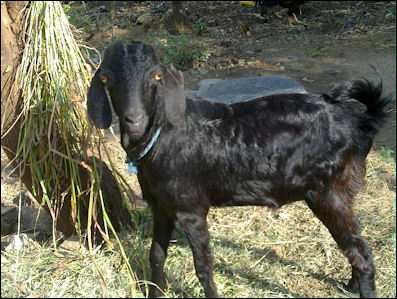
Goats are the perfect animal for an inhospitable environment. They eat almost anything; generally don't stray; can survive droughts that kill cows, pigs, cattle, chickens and sometimes even camels; supply meat, milk and cheese; and produce leather and hair that can be made into clothes, tents and other things. In some places they are used as beasts of burden. [Source: Robert Wernick, Smithsonian]
There are ten species of wild goats, including the ibex. A male goat is called a billy goat or a buck. A female is called a nanny goat or a doe. Young are called kids. A group is called a herd and used to be called a trip.
Goats are related to sheep. Both animal produce hair that can be used to make clothing. The most obvious difference between the two animals is that goat tails stand up while sheep tails hang down; male goats have beards while male sheep don't; and goats have straighter hair and go "eeehhhh,” “eeeehhh” while sheep go "baaaah." Some varieties of non-wool producing sheep have short hair and look sort of like goats.
Different kinds of goats are raised for different purposes: milk, meat, leather and wool. Some of the finest wools in the world come from the goats native to Tibet, Kashmir, and the Pamir mountains. Breeds of goats include : shaggy white Angoras, deep-chested beige Spaniards and New Zealand Kikos.
World’s Top Goat Exporting, Producing and Importing Countries
World’s Top Exporters of Goats (2020): 1) Somalia: 2000000 head; 2) Iran: 500000 head; 3) Oman: 500000 head; 4) Tanzania: 204658 head; 5) Syria: 150000 head; 6) India: 142524 head; 7) Mauritania: 130000 head; 8) Chad: 110000 head; 9) Djibouti: 88315 head; 10) Namibia: 85816 head; 11) Niger: 62228 head; 12) Thailand: 58086 head; 13) Mali: 20000 head; 14) Myanmar: 17634 head; 15) Uganda: 12619 head; 16) Kuwait: 12371 head; 17) Saudi Arabia: 11247 head; 18) South Africa: 10290 head; 19) Ethiopia: 9222 head; 20) France: 9043 head: [Source: FAOSTAT, Food and Agriculture Organization (U.N.), fao.org]
World’s Top Exporters (in value terms) of Goats (2020): 1) Somalia: US$180000,000; 2) Oman: US$75000,000; 3) Syria: US$30000,000; 4) Iran: US$20000,000; 5) Chad: US$11000,000; 6) Mauritania: US$6000,000; 7) Djibouti: US$4126,000; 8) India: US$4026,000; 9) Namibia: US$3597,000; 10) Australia: US$3549,000; 11) New Zealand: US$3528,000; 12) Tanzania: US$3327,000; 13) South Africa: US$2281,000; 14) Thailand: US$2243,000; 15) Netherlands: US$2213,000; 16) France: US$2021,000; 17) Saudi Arabia: US$1572,000; 18) Niger: US$1425,000; 19) Kuwait: US$1257,000; 20) Mali: US$1100,000
Top Goat-Producing Countries in 2008 (Production, $1000; Production, metric tons, FAO): 1) China, 2783575 , 1828208; 2) India, 740426 , 480852; 3) Nigeria, 406099 , 266719; 4) Pakistan, 397314 , 260950; 5) Bangladesh, 319739 , 210000; 6) Sudan, 289973 , 190449; 7) Iran (Islamic Republic of), 168236 , 110495; 8) Indonesia, 100789 , 66197; 9) Ethiopia, 98358 , 64600; 10) Niger, 92286 , 60612; 11) Somalia, 88080 , 57850; 12) Greece, 84198 , 55300; 13) Philippines, 80896 , 53131; 14) Mongolia, 72569 , 47662; 15) Kenya, 70319 , 46184; 16) Mali, 65655 , 43121; 17) Nepal, 65309 , 42894; 18) Mexico, 64805 , 42563; 19) Afghanistan, 63338 , 41600; 20) Turkey, 63308 , 41580.
World’s Top Importers of Goats (2020): 1) United Arab Emirates: 1100000 head; 2) Oman: 700000 head; 3) Senegal: 350000 head; 4) Yemen: 300000 head; 5) Saudi Arabia: 271836 head; 6) Jordan: 238847 head; 7) Kenya: 203241 head; 8) Kuwait: 89802 head; 9) Thailand: 86444 head; 10) Nepal: 80000 head; 11) South Africa: 78973 head; 12) Nigeria: 62037 head; 13) Laos: 61304 head; 14) Cote d’Ivoire: 60000 head; 15) Benin: 50000 head; 16) Oman: 20000 tonnes; 17) Guinea: 17000 head; 18) Democratic Republic of the Congo: 15000 head; 19) Netherlands: 14917 head; 20) South Sudan: 12538 head: [Source: FAOSTAT, Food and Agriculture Organization (U.N.), fao.org]
World’s Top Importers (in value terms) of Goats (2020): 1) Oman: US$100000,000; 2) United Arab Emirates: US$58000,000; 3) Jordan: US$35371,000; 4) Saudi Arabia: US$15498,000; 5) China: US$13428,000; 6) Senegal: US$11000,000; 7) Yemen: US$7000,000; 8) Nepal: US$7000,000; 9) Kuwait: US$6880,000; 10) Thailand: US$3860,000; 11) Kenya: US$3665,000; 12) South Africa: US$3236,000; 13) Cote d’Ivoire: US$3000,000; 14) Russia: US$2795,000; 15) Laos: US$2695,000; 16) Benin: US$2100,000; 17) Lebanon: US$2028,000; 18) Bahrain: US$2000,000; 19) Qatar: US$1654,000; 20) Nigeria: US$1592,000
Early History of Goats
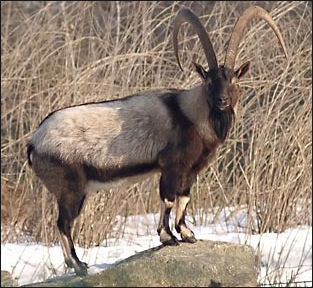
Bezoar goat Goats first appeared around 5 million years ago. The lived primarily in mountainous habitats and spread out and inhabited other regions. Modern goats can eat food that other animals can't partly because the originated from harsh, rocky mountain environments.
Mesopotamians wrote poems about goats, depicted them in golden sculptures, worshiped them as gods and made the goat-god Capricorn into a Zodiac sign. Goats have been taken all over the world to trade as sources of meat, wool and milk. Goats are mentioned in the Bible as well as in Buddhist, Confucian and Zoroastrian texts. In Greek myths, the gods were nursed on goats milk.
Mark Oliver wrote for Listverse:“Romans didn’t have Band-Aids, so they found another way to patch up wounds. According to Pliny the Elder, people in Rome patched up their scrapes and wounds with goat dung. Pliny wrote that the best goat dung was collected during the spring and dried but that fresh goat dung would do the trick “in an emergency.” “That’s an attractive image, but it’s hardly the worst way Romans used goat dung. Charioteers drank it for energy. They either boiled goat dung in vinegar or ground it into a power and mixed it into their drinks. They drank it for a little boost when they were exhausted. This wasn’t even a poor man’s solution. According to Pliny, nobody loved to drink goat dung more than Emperor Nero himself.” [Source: Mark Oliver, Listverse, August 23, 2016]
Goats have long gotten a bad rap. They have been characterized as both satanic and stupid. Chaucer called them “stinken.” Christians were the ones that gave the animals a bad name. They portrayed the devil as a part goat. This in part was inspired by imagery of part-goat-part-human, Greco-Roman satyrs. Ancient Hebrews coined the term "scapegoat.”
Domestication of Goats
Goats rank with pigs and dogs as one of the earliest domesticated animals and rank with sheep as one of the first animals to be kept for milk. Modern goats are believed to have been domesticated from Markor goats or Bezoar goats from Western Asia about 9,000 to 10,000 years ago. Wild Markor goats can still be found in the dry mountains of Afghanistan, Iran and Pakistan.
Bones from what appear to be domesticated goats, dated to from 8,500 B.C., have been found in Iraq and Iran. Ganj Dareh, a 10,000-year-old site in the Fertile Crescent, yielded a number bones of many small goats. Archeologist believe that these goats were domesticated rather than wild based on the practice of hunter societies to kill the largest animals available while herders kill smaller animals and keep the large ones to breed. People who lived in Iran 9,000 years ago kept a few males to breed and killed off the rest of the male goats at age two, about the time they reached sexual maturity, while females were allowed to grow older because they supplied milk and produced babies, a pattern that continues today.
Jordan was also a place where goats were domesticated very early. Excavations of structures and associated deposits left by hunter-gatherers in the Black Desert in eastern Jordan have revealed bones from wild sheep — a species previously not identified in this area in the Late Pleistocene. According to the team of University of Copenhagen archaeologists, who led the excavations, the discovery is further evidence that the region often seen as a ‘marginal zone’ was capable of supporting a variety of resources, including a population of wild sheep, 14,500 years ago.
Goat Characteristics and Behavior
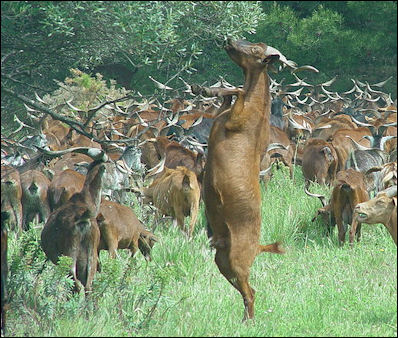
Adult goats can live to be 15 years old and weigh around 100 to 120 pounds. According to the Guinness Book of Records, the world's largest goat weighed 400 pounds; the oldest one lived to the age of 18; and highest milk yield for a goat was 7,714 pounds in one year.
Goats lack tear ducts. Like giraffes and camels, they have long tongues and leathery mouth interiors that allow them to carefully select the shoots and leaves they want and eat them without injuring themselves.
Goats are cud-chewing ruminants. Cheap to feed and sometimes called "the poor man's cow,” they are primarily browsers who prefer brush, foliage on low branches and even bark to grass. Individual goats are sometimes observed getting in their hind legs and pulling down branches so other goats can feed on them. In some parts of the world you can see goats climb trees and sit on branches. Like sheep, goat need food sources that are within distances that they are capable of traveling. See Ruminants Under MAMMALS: HAIR, HIBERANTION AND RUMINANTS factsanddetails.com
The reputation that goats have of "eating anything" and munching on tin cans is something of a myth. Goats are curious animals. They often investigate things like tin cans by chewing on them but they don't eat them (they are probably just trying to eat the glue on the label). They often reject hay and grain that is not clean.
Goats have a reputation of being unpredictable and frisky. They gave birth to the word of "capricious" after all. In contrast sheep are regarded as docile. Female goats are generally odorless but males sometimes have a strong smell in the mating season, the result of them urinating on themselves.
Goats can breed before their first birthday and multiply quickly. The gestation period is 21 to 22 weeks. One to three kids are born with their eyes open. Newborns can follow their mothers about and even climb mountainsides within a few hours after birth. They reach maturity at six months.
Goats, People and the Environment
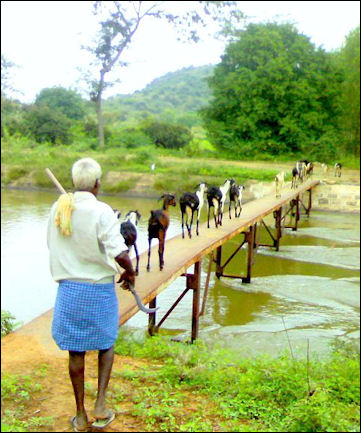
Goats are raised mostly for milk and meat but are also sources of cashmere sweaters, leather, kid gloves, bookbindings, shoes and chevre cheese. Kidskin is prized for its softness, pliability and durability. Often what is sold in stores is imitation kidskin made from dog or rat skins.
Goat herders typically spend seven hours a day every day with their animals in the mountains. When they are five or six rural children begin helping their sibling tend goats and other animals. When they are seven or eight they have enough skill to take care of 20 or so goats on their own.
Goats are trainable like dogs. They have been taught to do tricks. In California, goats have been enlisted to eat brush and grass considered a fire hazard. About 350 of them can denude an acre a day. Goats were first cloned in 2000. The first one died of abnormal lung development.
Goats are sometimes called the scourge of the developing world. They eat grasses right down to the root, often killing the plants and laying waste to semi-desert regions, turning them into full- fledged deserts. Once grasses have been eaten down to the root they have a hard time reestablishing themselves.
Goats are also great destroyers of forests. They can climb trees and eat all the leaves from branches, and have foiled many reforestation programs by eating all the leaves off seedlings. Many feel goats are not to blame, people are to blame because they bring the goats to environments that are overtaxed.
Goat Meat
Goat is the most widely consumed meat in the world. It is a staple of Indian, Mexican, Greek and Italian cuisines. China is the world’s largest producer. Koreans think it increase the sex drive of women.
Goat meat is lower in fat than chicken and higher in protein than beef. It is sometime tough with a flavor somewhere between beef and lamb. Marinating the meat makes it less tough and accentuates the flavor.
Goat meat tends to be lean and is best braised or cooked with moist heat, so it won’t fry out. Describing goat meat served at an Okinawan restaurant Tom Bake wrote in the Daily Yomiuri, “the meat was pale and lean-looking, but as soft and chewy as one might expect much fattier flesh to be. There was no particular odor.”
Young or baby goat meat that has been marinated for some period of time is said to the tastiest. One tip on preparing goat from Madam Guinaudeau’s “Traditional Moroccan Cooking” goes: “Make a hole with the point of the knife just above the knee joint of one of the legs between flesh and skin. Blow through the opening until the air gets to the fore legs and make them stick up.”
World’s Top Goat Meat and Fat Producing and Exporting Countries
World’s Top Producers of Goat Meat (2020): 1) China: 2305937 tonnes; 2) India: 554813 tonnes; 3) Pakistan: 504000 tonnes; 4) Nigeria: 261108 tonnes; 5) Bangladesh: 231153 tonnes; 6) Ethiopia: 147741 tonnes; 7) Chad: 132296 tonnes; 8) Mongolia: 129163 tonnes; 9) Sudan: 121008 tonnes; 10) Myanmar: 115444 tonnes; 11) Yemen: 80955 tonnes; 12) Kenya: 80739 tonnes; 13) Nepal: 75023 tonnes; 14) Indonesia: 69804 tonnes; 15) Iran: 65385 tonnes; 16) United Arab Emirates: 60995 tonnes; 17) Malawi: 57884 tonnes; 18) Saudi Arabia: 55454 tonnes; 19) Afghanistan: 46546 tonnes; 20) Tanzania: 43070 tonnes [Source: FAOSTAT, Food and Agriculture Organization (U.N.), fao.org]
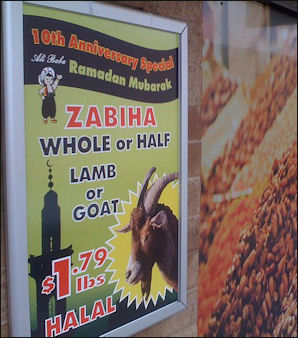
Halal meat store World’s Top Exporters of Goat Meat (2020): 1) Australia: 13064 tonnes; 2) Ethiopia: 10889 tonnes; 3) Kenya: 10313 tonnes; 4) Spain: 3936 tonnes; 5) France: 2182 tonnes; 6) New Zealand: 1458 tonnes; 7) Greece: 1238 tonnes; 8) Netherlands: 952 tonnes; 9) China: 930 tonnes; 10) Pakistan: 861 tonnes; 11) Sudan: 755 tonnes; 12) United Arab Emirates: 437 tonnes; 13) Italy: 334 tonnes; 14) Singapore: 310 tonnes; 15) Myanmar: 236 tonnes; 16) Romania: 189 tonnes; 17) United States: 157 tonnes; 18) Kuwait: 157 tonnes; 19) Zimbabwe: 130 tonnes; 20) Hong Kong: 99 tonnes
World’s Top Exporters (in value terms) of Goat Meat (2020): 1) Australia: US$100072,000; 2) Ethiopia: US$61829,000; 3) Kenya: US$47868,000; 4) France: US$16930,000; 5) Spain: US$16433,000; 6) China: US$11208,000; 7) New Zealand: US$9695,000; 8) Greece: US$7053,000; 9) Pakistan: US$6004,000; 10) Sudan: US$4183,000; 11) Netherlands: US$4173,000; 12) United Arab Emirates: US$1730,000; 13) Italy: US$1477,000; 14) Myanmar: US$1180,000; 15) Singapore: US$1048,000; 16) Kuwait: US$971,000; 17) Romania: US$675,000; 18) Hong Kong: US$413,000; 19) United States: US$369,000; 20) Portugal: US$342,000
Offals are the intestines and internal organs of an animal consumed as food. World’s Top Producers of Edible Goat Offals (2020): 1) China: 405845 tonnes; 2) Pakistan: 142435 tonnes; 3) India: 83726 tonnes; 4) Bangladesh: 66044 tonnes; 5) Ethiopia: 42979 tonnes; 6) Nigeria: 41777 tonnes; 7) Mongolia: 41097 tonnes; 8) Nepal: 27008 tonnes; 9) Myanmar: 26641 tonnes; 10) Sudan: 24202 tonnes; 11) Chad: 22490 tonnes; 12) Kenya: 17178 tonnes; 13) Yemen: 16191 tonnes; 14) United Arab Emirates: 12199 tonnes; 15) Indonesia: 12030 tonnes; 16) Iran: 11694 tonnes; 17) Tanzania: 11198 tonnes; 18) Uganda: 10767 tonnes; 19) Malawi: 10719 tonnes; 20) Saudi Arabia: 10425 tonnes
World’s Top Producers of Goat Fat (2020): 1) China: 92237 tonnes; 2) Pakistan: 32870 tonnes; 3) India: 22193 tonnes; 4) Bangladesh: 16983 tonnes; 5) Nigeria: 6267 tonnes; 6) Ethiopia: 5910 tonnes; 7) Yemen: 4048 tonnes; 8) Sudan: 3630 tonnes; 9) Indonesia: 3564 tonnes; 10) Myanmar: 3552 tonnes; 11) Mongolia: 3523 tonnes; 12) Chad: 3175 tonnes; 13) Nepal: 3001 tonnes; 14) Iran: 2389 tonnes; 15) Kenya: 2233 tonnes; 16) Australia: 2192 tonnes; 17) Saudi Arabia: 1996 tonnes; 18) Malawi: 1929 tonnes; 19) Afghanistan: 1710 tonnes; 20) Tanzania: 1464 tonnes
World’s Top Goat Meat Importing Countries
World’s Top Importers of Goat Meat (2020): 1) United Arab Emirates: 14296 tonnes; 2) United States: 9799 tonnes; 3) Portugal: 2161 tonnes; 4) Taiwan: 1832 tonnes; 5) France: 1433 tonnes; 6) Saudi Arabia: 1174 tonnes; 7) Canada: 1173 tonnes; 8) South Korea: 1161 tonnes; 9) Bahrain: 1097 tonnes; 10) Oman: 1028 tonnes; 11) Italy: 999 tonnes; 12) Sri Lanka: 933 tonnes; 13) United Kingdom: 818 tonnes; 14) Hong Kong: 783 tonnes; 15) Trinidad and Tobago: 768 tonnes; 16) Qatar: 616 tonnes; 17) Spain: 459 tonnes; 18) Japan: 444 tonnes; 19) Singapore: 330 tonnes; 20) Somalia: 271 tonnes [Source: FAOSTAT, Food and Agriculture Organization (U.N.), fao.org]
World’s Top Importers (in value terms) of Goat Meat (2020): 1) United Arab Emirates: US$91106,000; 2) United States: US$78176,000; 3) Portugal: US$14731,000; 4) Taiwan: US$12254,000; 5) South Korea: US$9669,000; 6) Canada: US$8429,000; 7) Hong Kong: US$8159,000; 8) France: US$7317,000; 9) Italy: US$7100,000; 10) Trinidad and Tobago: US$6540,000; 11) Saudi Arabia: US$6521,000; 12) Spain: US$6378,000; 13) Bahrain: US$4694,000; 14) Oman: US$4461,000; 15) Japan: US$3587,000; 16) Qatar: US$3421,000; 17) United Kingdom: US$3286,000; 18) Sri Lanka: US$2280,000; 19) Kuwait: US$1587,000; 20) China: US$1485,000
Goat Milk
Goats produce four to six pounds of milk a day for 10 months out of the year. They produce less milk than other animals but their the milk is very nutritious. Goat milk has smaller fat globules and softer curd than cow's milk. It is easier to digest and sometimes used in formulas for infants. The cream is naturally homogenized, which means it is difficult to separate and can not be skimmed of like cow milk cream.
Goat milk is about 3.8 percent fat, compared to 3.6 percent for cow’s milk but it is lower in cholesterol and higher in key nutrients such as vitamin A (86 percent more than cow’s milk); vitamin B-1 (51 percent more) and riboflavin (32 percent more).
In many places, goat milk is heated and spiked with a little bit of day old yoghurt. After it sits for a while the milk is then shaken back and forth inside a goat skin and fresh yoghurt is scraped off the inside.
World’s Top Goat Milk and Cheese Producing Countries
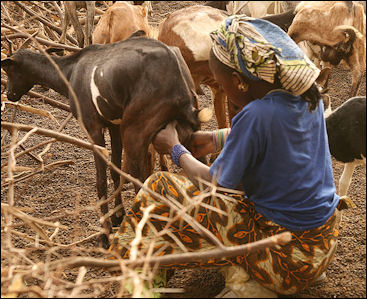
goat milking
World’s Top Producers of Whole Fresh Goat Milk (2020): 1) India: 5888077 tonnes; 2) Bangladesh: 2671911 tonnes; 3) Sudan: 1165043 tonnes; 4) Pakistan: 965000 tonnes; 5) France: 679300 tonnes; 6) Turkey: 554143 tonnes; 7) Spain: 523900 tonnes; 8) South Sudan: 467148 tonnes; 9) Niger: 407346 tonnes; 10) Netherlands: 407000 tonnes; 11) Somalia: 377742 tonnes; 12) Indonesia: 370708 tonnes; 13) Greece: 361350 tonnes; 14) Iran: 350831 tonnes; 15) Algeria: 332779 tonnes; 16) Brazil: 298377 tonnes; 17) Kenya: 276178 tonnes; 18) Mali: 255226 tonnes; 19) Russia: 254357 tonnes; 20) Romania: 240800 tonnes [Source: FAOSTAT, Food and Agriculture Organization (U.N.), fao.org. A tonne (or metric ton) is a metric unit of mass equivalent to 1,000 kilograms (kgs) or 2,204.6 pounds (lbs). A ton is an imperial unit of mass equivalent to 1,016.047 kg or 2,240 lbs.]
World’s Top Producers (in terms of value) of Whole Fresh Goat Milk (2019): 1) India: Int.$2484493,000 ; 2) Bangladesh: Int.$1265251,000 ; 3) Sudan: Int.$532786,000 ; 4) Pakistan: Int.$432486,000 ; 5) France: Int.$302160,000 ; 6) Turkey: Int.$265569,000 ; 7) Spain: Int.$246512,000 ; 8) South Sudan: Int.$211694,000 ; 9) Niger: Int.$180208,000 ; 10) Netherlands: Int.$177595,000 ; 11) Somalia: Int.$171797,000 ; 12) Indonesia: Int.$170042,000 ; 13) Greece: Int.$163682,000 ; 14) Brazil: Int.$130569,000 ; 15) Kenya: Int.$125712,000 ; 16) Iran: Int.$125183,000 ; 17) Algeria: Int.$116552,000 ; 18) Russia: Int.$113978,000 ; 19) Mali: Int.$111835,000 ; 20) Romania: 108766,000 ; [An international dollar (Int.$) buys a comparable amount of goods in the cited country that a U.S. dollar would buy in the United States.]
World’s Top Producers of Goat Milk Cheese (2019): 1) South Sudan: 112200 tonnes; 2) Sudan: 90841 tonnes; 3) Spain: 51700 tonnes; 4) Niger: 42301 tonnes; 5) Iran: 34079 tonnes; 6) Mexico: 16689 tonnes; 7) Tajikistan: 13740 tonnes; 8) Afghanistan: 10677 tonnes; 9) China: 6693 tonnes; 10) Bolivia: 4693 tonnes; 11) Morocco: 4593 tonnes; 12) Ukraine: 4561 tonnes; 13) Portugal: 4339 tonnes; 14) Yemen: 3684 tonnes; 15) Syria: 3532 tonnes; 16) Iraq: 2539 tonnes; 17) Lebanon: 1718 tonnes; 18) Norway: 1196 tonnes; 19) Chile: 1186 tonnes; 20) Tunisia: 1154 tonnes
Cashmere and Goat Skins
Cashmere is a kind of wool that comes from downy undercoats of cashmere goats, which are native to Inner Mongolia. The undercoat helps keep the goats warm in temperatures that can drop as low as -40̊F in the winter. Cashmere was first used to make Indian shawls and now is used mostly to make cashmere sweaters that are valued for their “understated luxury” and “unshowy self-indulgence”and sell for as much $1,000. [Source: Rebecca Mead, The New Yorker, February 1, 1999]
Cashmere was prized in ancient Rome as a luxury item and has periodically been a fashion item ever since. Beau Brummel made white cashmere waist coats all the rage for men in the 19th century. Napoleon popularized cashmere shawls after he gave 17 of them to his second wife. The best cashmere is comprised of fine, long fibers. The fineness of the fibers is what makes cashmere so warm and soft. The finest quality cashmere has luster, heft and loft. Poor quality “feels dead, dry and boardy.”
Cashmere goats are slightly small than ordinary goats. They have long curling horns and grow long shaggy coats of hair. In the winter they grow a fine, dense, downy undercoat to protect them from the harsh cold. During the spring hair from this undercoat is combed by herders before the animals have a chance to shed it. Contrary to what many people believe the undercoat grows all over their body, nott just their underbelly.
See Separate Article CASHMERE factsanddetails.com
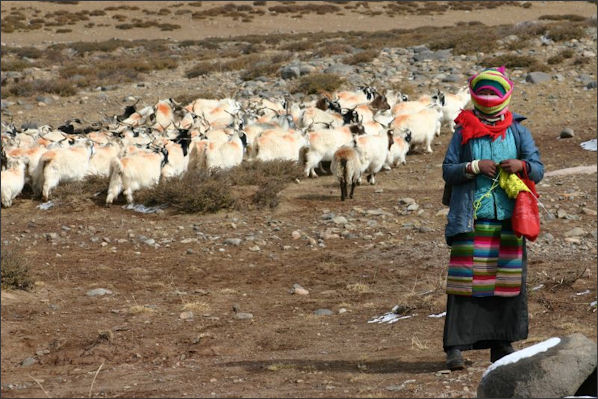
Tibetan shepherd girl with cashmere goats
World’s Top Producers of Fresh Goat Skins (2020): 1) China: 461187 tonnes; 2) Pakistan: 120522 tonnes; 3) India: 100875 tonnes; 4) Bangladesh: 66044 tonnes; 5) Nigeria: 41777 tonnes; 6) Mongolia: 35226 tonnes; 7) Ethiopia: 34921 tonnes; 8) Kenya: 25768 tonnes; 9) Chad: 24342 tonnes; 10) Sudan: 23234 tonnes; 11) Myanmar: 23089 tonnes; 12) Yemen: 16191 tonnes; 13) Indonesia: 14852 tonnes; 14) Nepal: 12454 tonnes; 15) Iran: 11694 tonnes; 16) Malawi: 10183 tonnes; 17) Saudi Arabia: 9871 tonnes; 18) Burkina Faso: 8919 tonnes; 19) Tanzania: 8614 tonnes; 20) Mexico: 8000 tonnes [Source: FAOSTAT, Food and Agriculture Organization (U.N.), fao.org]
The top goatskin producers in the 1970s were 1) India; 2) Pakistan; 3) Nigeria; 4) Ethiopia; 5) Brazil; 6) Argentina.
Image Sources: Wikimedia Commons
Text Sources: New York Times, Washington Post, Los Angeles Times, Times of London, Yomiuri Shimbun, The Guardian, National Geographic, The New Yorker, Time, Newsweek, Reuters, AP, Lonely Planet Guides, Compton’s Encyclopedia and various books and other publications.
Last updated April 2022
